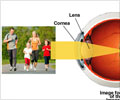
Now, the Japanese study has observed for the first time an equally strange illusion: The afterimage appears in a "complementary" shape-circles as hexagons, and vice-versa.
"The finding suggests that the afterimage is formed in the brain, not in the eye," the author, Hiroyuki Ito of Kyushu University, wrote in an email.
More specifically, the illusion is produced in the brain's shape-processing visual cortex, not the eye's light-receiving, message-sending retina.
Ito eliminated the theory that the afterimage was a manifestation of "retinal bleaching"-when the photoreceptors on the retina become ineffective or fatigued through prolonged exposure to light.
Viewing static circles or hexagons produce circular or hexagonal bleached areas on the retina.
Advertisement
Neither could the retina transfer information taken in by the left eye to produce an afterimage in the right eye. "The only site that can happen is the brain," the author said.
Advertisement
"People tend to think that afterimages are meaningless by-products arising from the physiological characteristics of the eye," wrote Ito.
"But I think that the afterimages reflect brain activities and provide us the means to know those activities in a directly visible form," he added.
The findings will appear in an upcoming issue of Psychological Science, a journal published by the Association for Psychological Science.
Source-ANI















